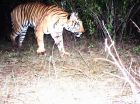(Press-News.org) Each year in the Northern Hemisphere, levels of atmospheric carbon dioxide drop in the summer as plants "inhale," then climb again as they exhale after the growing season.
During the last 50 years, the size of this seasonal swing has increased by as much as half, for reasons that aren't fully understood.
Now a team of researchers has shown that agricultural production may generate up to a quarter of the increase in this seasonal carbon cycle, with corn playing a leading role.
"This study shows the power of modeling and data mining in addressing potential sources contributing to seasonal changes in carbon dioxide," says Liz Blood, program director for the National Science Foundation's MacroSystems Biology Program, which funded the research. "It points to the role of basic research in finding answers to complex problems."
In the Northern Hemisphere, there's a strong seasonal cycle of vegetation, says scientist Mark Friedl of Boston University (BU), senior author of a paper reporting the results in this week's issue of the journal Nature.
"Something is changing about this cycle," says Friedl. "Ecosystems are becoming more productive, pulling in more atmospheric carbon during the summer and releasing more during the dormant period."
Most of this annual change is attributed to the effects of higher temperatures driven by climate change--including longer growing seasons, quicker uptake of carbon by vegetation and the "greening" of higher latitudes with more vegetation.
"But that's not the whole story," says Josh Gray of BU, lead author of the paper. "We've put humans and croplands into the story."
The scientists gathered global production statistics for four leading crops--corn, wheat, rice and soybeans--that together represent about 64 percent of all calories consumed worldwide.
They found that production of these crops in the Northern Hemisphere has more than doubled since 1961 and translates to about a billion metric tons of carbon captured and released each year.
These croplands are "ecosystems on steroids," says Gray, noting that they occupy about 6 percent of the vegetative land area in the Northern Hemisphere, but are responsible for up to a quarter of the total increase in seasonal carbon exchange of atmospheric carbon dioxide.
The growth in seasonal variation doesn't have a huge impact on global terrestrial carbon uptake and release, he says, since carbon gathered by the crops is released each year.
However, understanding the effects of agricultural production, the researchers maintain, will help improve models of global climate, particularly in discovering how well ecosystems will buffer rising levels of carbon dioxide in the future.
The BU investigators collaborated with a team of scientists, including Eric Kort of the University of Michigan, Steve Frolking of the University of New Hampshire, Christopher Kucharik of the University of Wisconsin, Navin Ramankutty of the University of British Columbia and Deepak Ray of the University of Minnesota.
The work highlights extraordinary increases in crop production in recent decades.
"These indications of increased productivity speak well for agriculture," says Tom Torgersen, program director for the National Science Foundation's Water Sustainability and Climate Program, which also funded the research. "But such enhanced agricultural productivity makes significant demands on water supplies, which will require further investigation. "
Adds Friedl, "It's a remarkable story of what we've done in agriculture in general. And in particular in corn, which is one crop that's just exploded."
Corn alone accounts for two-thirds of the crop contribution to the increased seasonal exchange in carbon, he says. Almost 90 percent is produced in the midwestern United States and China.
"Over the last 50 years, the area of croplands in the Northern Hemisphere has been relatively stable, but production has intensified enormously," Friedl says.
"The fact that this land area can affect the composition of the atmosphere is an amazing fingerprint of human activity on the planet."
INFORMATION:
The U.S. Department of Health and Human Services today issued a Notice of Proposed Rulemaking (NPRM), which proposes regulations to implement reporting requirements for clinical trials that are subject to Title VIII of the Food and Drug Administration Amendments Act of 2007 (FDAAA). The proposed rule clarifies requirements to clinical researchers for registering clinical trials and submitting summary trial results information to ClinicalTrials.gov, a publicly accessible database operated by the National Library of Medicine, part of the National Institutes of Health. A ...
Geologists in Syracuse University's College of Arts and Sciences have recently figured out what has caused the Alaska Range to form the way it has and why the range boasts such an enigmatic topographic signature. The narrow mountain range is home to some of the world's most dramatic topography, including 20,320-foot Mount McKinley, North America's highest mountain.
Professor Paul Fitzgerald and a team of students and fellow scientists have been studying the Alaska Range along the Denali fault. They think they know why the fault is located where it is and what accounts ...
It's hard to believe, but there are similarities between bean sprouts and human cancer.
In bean sprouts, a collection of amino acids known as a protein complex allows them to grow longer in the darkness than in the light. In humans, a similar protein complex called CSN and its subunit CSN6 is now believed to be a cancer-causing gene that impacts activity of another gene (Myc) tied to tumor growth.
Somehow the same mechanisms that result in bigger bean sprouts, also cause cancer metastasis and tumor development.
A study at The University of Texas MD Anderson Cancer ...
Human-wildlife conflict resolution near protected areas critical for tiger survival
Stripe-matching software and individual histories inform decisions on handling conflict-prone big cats
NEW YORK (November 18, 2014)--Researchers with the Wildlife Conservation Society and other partners in India are using high-tech solutions to zero in on individual tigers in conflict and relocate them out of harm's way for the benefit of both tigers and people.
In recent tiger-conflict cases involving both a human fatality and the predation of livestock, both occurring near two of ...
Nearly 30,000 people become living kidney donors worldwide each year, and many are young women. Researchers at the Institute for Clinical Evaluative Sciences (ICES), Lawson Health Research Institute and Western University set out to determine if being a living donor has any effect on future pregnancies.
The study, published in the New England Journal of Medicine, found living kidney donors were more likely to be diagnosed with gestational hypertension (high blood pressure) or preeclampsia than non-donors.
Preeclampsia is a pregnancy complication characterized by high ...
South Asian boys are three times as likely to be overweight compared to their peers, according to a new Women's College Hospital study.
The report, which was recently published in the Journal of Racial and Ethnic Health Disparities, was one of the first to look at ethnic group differences in overweight children living in Canada.
"Our findings are alarming. From a young age, South Asian boys appear to be on a path towards developing serious health conditions," said Ananya Banerjee, PhD, lead researcher of the study.
Previous work has established that, in Canada, type ...
Recently published research by U.S. Forest Service economist Jeff Prestemon supports the contention that the 2008 Lacey Act Amendment reduced the supply of illegally harvested wood from South America and Asia available for export to the United States.
Using monthly import data from 1989 to 2013, Prestemon, Project Leader of the Forest Service Southern Research Station Forest Economics and Policy unit, applied alternative statistical approaches to evaluate the effects of the 2008 amendment. The Journal of Forest Policy and Economics recently published the results online. ...
CHICAGO - Women who take a common type of medication to control their blood pressure are not at increased risk of developing breast cancer due to the drug, according to new study by researchers at the Intermountain Medical Center Heart Institute in Murray, Utah.
Researchers analyzed the records of more than 3,700 women who had no history of breast cancer, and who had long-term use of calcium channel blocker medications to control their blood pressure. Researchers found only a minimal increase in risk in one study and a 50 percent reduced risk in a second, leading them ...
Inspired perhaps by Harry Potter's invisibility cloak, scientists have recently developed several ways--some simple and some involving new technologies--to hide objects from view. The latest effort, developed at the University of Rochester, not only overcomes some of the limitations of previous devices, but it uses inexpensive, readily available materials in a novel configuration.
"There've been many high tech approaches to cloaking and the basic idea behind these is to take light and have it pass around something as if it isn't there, often using high-tech or exotic ...
Attending to and caring about the emotions of employees and colleagues - that's for wimps, not for tough businesspeople and efficient performers, right? Wrong! An extensive international study has now shown: The "ability to recognize emotions" affects income. The corresponding author of the study is Professor Dr. Gerhard Blickle of the Department of Psychology at the University of Bonn. The results are published in the Journal of Organizational Behavior.
"Although managing employees and dealing with people often involves reading their emotions and determining their moods, ...




